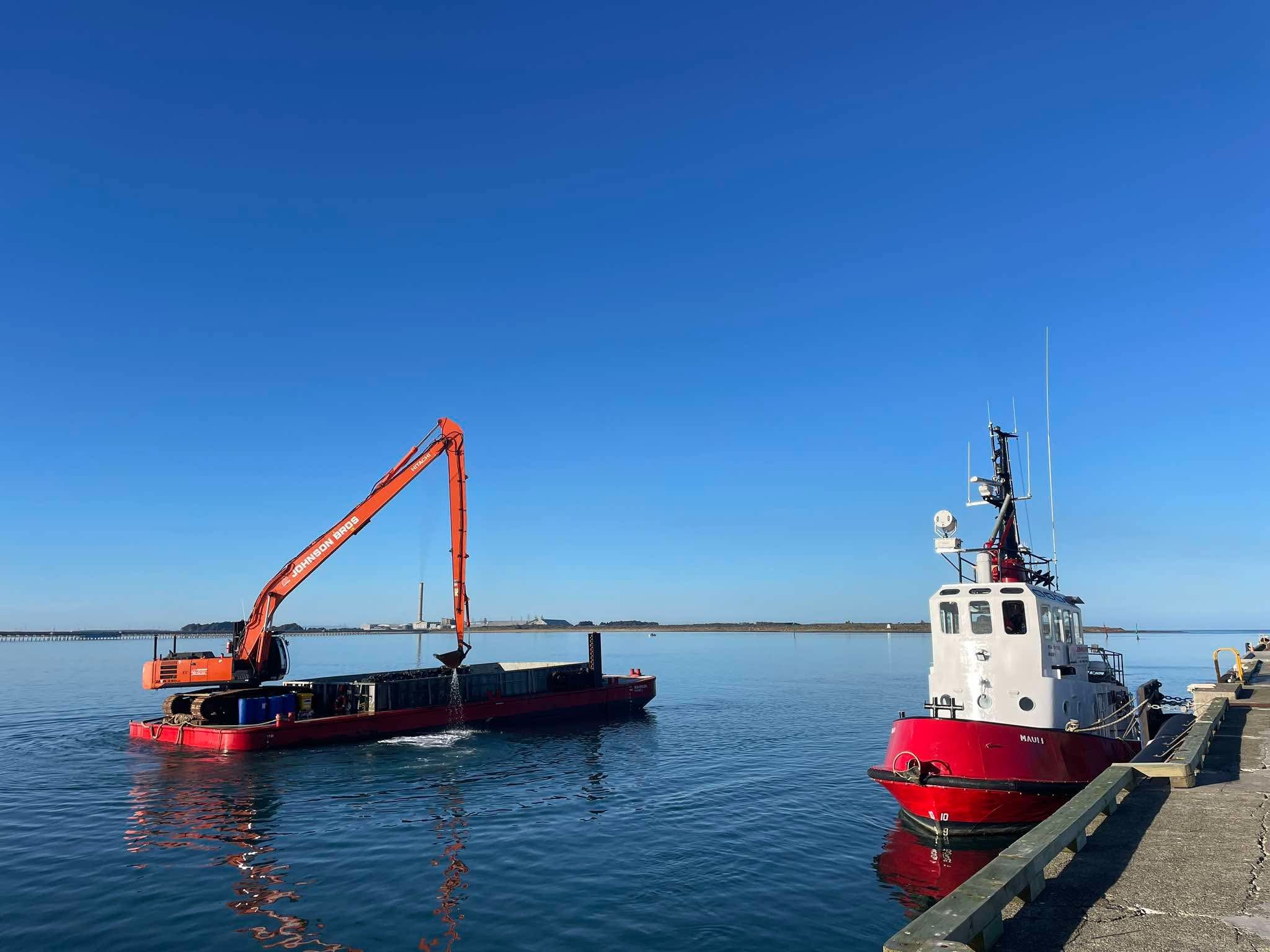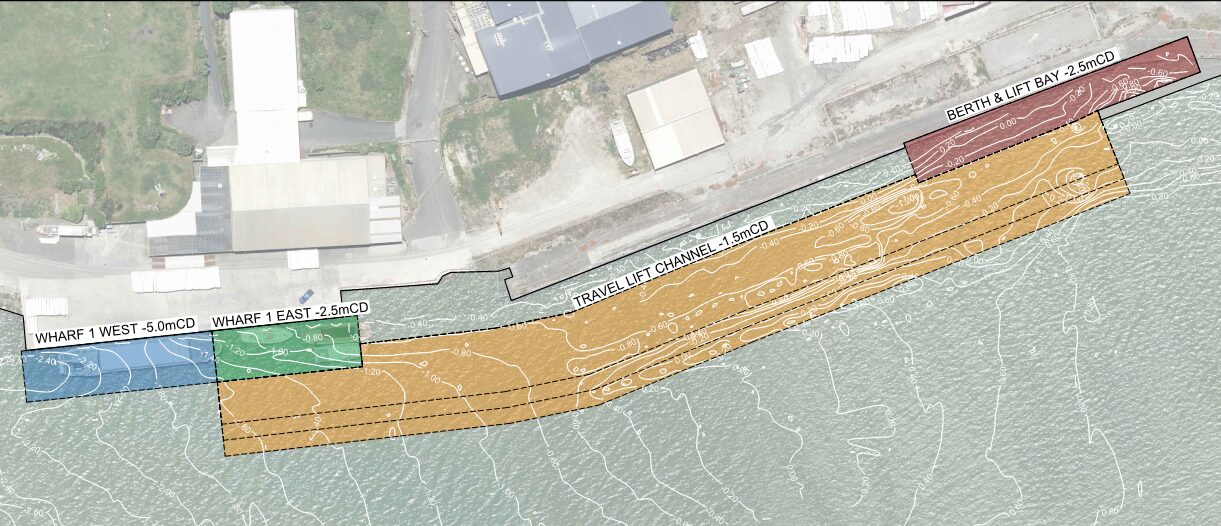Dredging Activities
Sediment flowing down the Whanganui River has built up over time in the Whanganui Port basin. It flows into the basin through the hole in the port basin training wall, creating an eddy, and is unable to escape back into the main channel unaided.
Because regular dredging has not occurred for a number of years, the silt has built up over time, to the point that access has become difficult for commercial operators, recreational boat owners, and the Whanganui Coastguard.
Dredging of the Whanganui Port basin transports the silt back into the main channel of the awa and therefore opens up the port basin for greater use.
While there are other access points for recreational vessels to the Whanganui River, the Wharf Street boat ramp remains the most suitable due to its proximity to the moana, large parking area, and proximity to access roads.
Emergency dredging works in the Whanganui Port basin
Emergency dredging works have begun in the Whanganui Port basin, during the atutahi (whitebait) season. This follows approval of a one-off consent variation by Horizons Regional Council.
The dredging is required to enable a clear channel in the Whanganui Port Basin. We acknowledge dredging during the whitebait season is far from ideal. However, without this work, local businesses would face significant disruption, putting jobs and the wider Te Pūwaha Whanganui Port revitalisation project at risk.
Getting this work consented has required a culmination of approvals and we have had to work extensively with the Department of Conservation, and Horizons Regional Council’s regulatory team. Hapū at place have guided the project through a process that has ensured this is a one-off.
Safeguarding the health of the awa remains our highest priority. Robust environmental protections are in place, including:
- Silt curtains to contain suspended sediment.
- Independent monitoring and oversight by hapū.
- No discharge to the river – all dredged material will be transported to approved land-based disposal sites.
- Time limits – works will be completed as quickly as possible, and no later than the end of October.
Hapū representatives will maintain real-time oversight of the dredging, with the authority to halt works if consent conditions are not being met. Independent assessments will also be carried out before, during, and after dredging to ensure silt curtains are effective and no sediment escapes into the river.
A silt curtain is a floating barrier placed in the water during works like dredging. It helps stop sediment from spreading, keeping the water clearer and protecting fish and the environment.
The Wharf Street boat ramp will remain open during the operation, with short closures possible from time to time. Personnel will be on site to assist the public and encourage safe boating.
- Initial dredging will use a long-reach excavator in the mobile boat hoist lift-out bay.
- Later in September, the Johnson & Bros dredge Mahikuri – a 25-metre purpose-built multipurpose barge – will arrive to complete the works.
- The Mahikuri is set up with a bucket and excavator and has almost twice the capacity of previous dredging operations.

The Mahikuri dredging in Bluff
The sediment will be disposed to trucks at the wharf that will initially transport it to a temporary, contained site on Wharf 2. Controls will be in place at this site to ensure the sediment remains fully contained and does not impact surrounding land or the awa. Further disposal sites are yet to be determined.
We acknowledge that dredging during atutahi (whitebait) season is not ideal. However, previous trials have been unsuccessful, leaving us behind schedule
Getting this work consented has required a culmination of approvals and we have had to work extensively with the Department of Conservation, and Horizons Regional Council’s regulatory team. Hapū at place have guided the project through a process that has ensured this is a one-off, given the unprecedented pressure facing the project, and ultimately our wider community if this work cannot proceed.
After hatching in freshwater streams and rivers, atutahi (whitebait) larvae are washed out to sea where they spend several months growing. As juveniles, they migrate back inland during spring (September-October), forming the whitebait shoals seen in rivers and estuaries. They then move upstream into freshwater habitats, where they mature into adults and complete their life cycle. The disturbance of silt affects the juvenile atutahi (whitebait) as they migrate.
The Whanganui Port basin is not a spawning site, these are further upstream in the Whanganui River.
The variation ensures that this activity occurs in a small area, and was granted on the basis that no dredged materials are placed into the river. Strict controls are in place to ensure any sediment that is stirred up is contained and managed appropriately. Hapū representatives will maintain real-time oversight of the dredging, with the authority to halt works if consent conditions are not being met. Independent assessments will also be carried out before, during, and after dredging to ensure silt curtains are effective and no sediment escapes into the river.
Protecting Te Awa Tupua remains our highest priority. Safeguards include:
- Silt curtains to contain suspended sediment.
- Independent monitoring and oversight by hapū.
- No discharge to the river – all dredged material will be disposed of at approved land-based sites.
- Time limits – works will be completed as quickly as possible and by the end of October at the latest.
No. This is a one-off variation to address urgent operational needs. It does not change long-term consent conditions or set a precedent for future dredging during whitebait season.
The initial works will be carried out by the Whanganui Port dredge operator using a long-reach excavator from land. The Johnson & Bros dredge Mahikuri, a purpose-built 25m flat-top multipurpose barge with advanced dredging capability, has also been contracted and is well-suited to the awa’s conditions.
The sediment will be disposed to trucks at the wharf that will initially transport it to a temporary, contained site on Wharf 2. Considerable controls will be in place at this site to ensure the sediment remains fully contained and does not impact surrounding land or the awa. Further disposal sites are yet to be determined.
Dredging will begin mid-September and will be completed by the end of October at the latest, depending on river conditions and equipment.
The Wharf Street boat ramp will remain open during the operation, with short closures possible from time to time. Personnel will be on site to assist the public and encourage safe boating.
As a result of last month’s unsuccessful dredging operation, the Mahikuri dredge has been contracted because of its capability and proven experience in similar conditions to the Whanganui River. Their equipment includes a long reach excavator, and they have the capability to dispose of the dredged materials to trucks on land.
The intention is to lodge the long-term dredging consent application later this year. Our dredging trials to date have helped inform the methodology we wish to use, and we are currently investigating disposal sites, including out to sea.
The application will also include a proposal to close the hole in the training wall.
A reclamation area upstream of the Whanganui Port basin has not been included in the scope of this application.
We are committed to transparency. Updates will be shared through media releases, the Whanganui Port website – www.whanganuiport.co.nz, social media via facebook.com/whanganuiportNZ, and regular communications with stakeholders. Monitoring results and lessons learned will also be shared after the project.
The public can also contact us on portproject@whanganui.govt.nz
- Follow us on Facebook for regular updates
- Email the project team – portproject@whanganui.govt.nz



